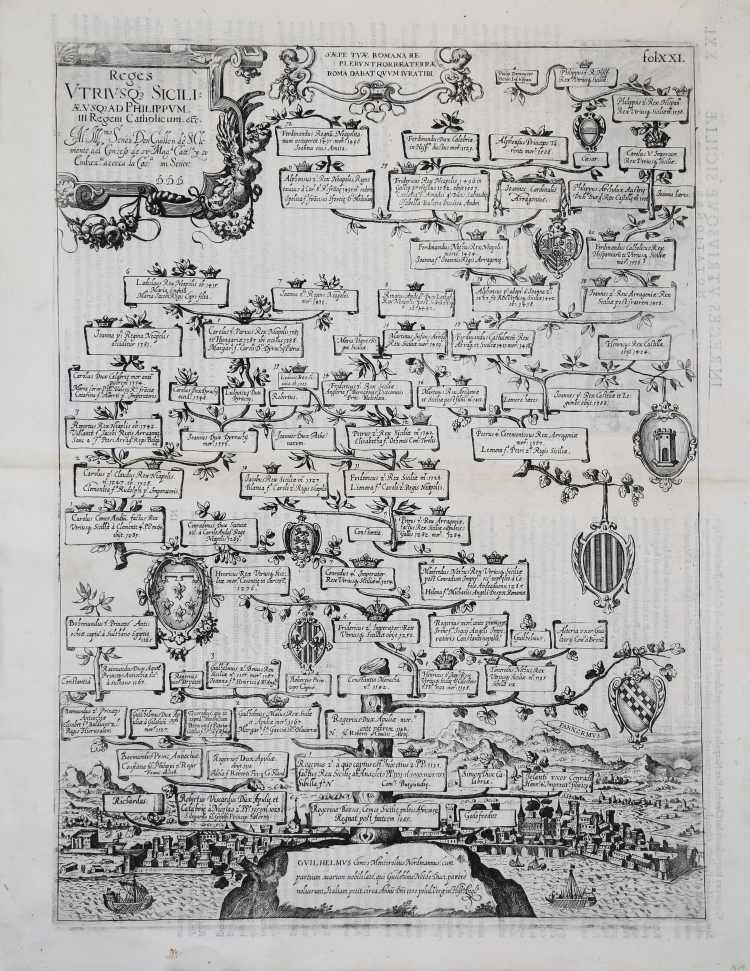




| Reference: | S48530 |
| Author | Antonio ALBIZZI |
| Year: | 1612 |
| Zone: | Palermo |
| Printed: | Augsburg |
| Measures: | 375 x 520 mm |



| Reference: | S48530 |
| Author | Antonio ALBIZZI |
| Year: | 1612 |
| Zone: | Palermo |
| Printed: | Augsburg |
| Measures: | 375 x 520 mm |
Albero genealogico della monarchia del Regno di Sicilia, dal Medioevo (1085) a Filippo III di Spagna (m. 1621); in basso è incisa una bella veduta di Palermo, capitale del Regno, dal mare.
La tavola è tratta dal celebre libro di Antonio Albizzi, “Principum Christianorum Stemmata ab Antonio Albizio Nobilis Florentino Collecta. Cum breuibus eiusdem notationib. pars ex Archivis Pp. desc Adiecto stemmate Dominici Custodis. Anversa. Nunc Civis Aug. ærj incisa. Augustae Vindelicor[um]. A° [M.D.]CXII. Cum privilegio S.C.M.tis ad an. decem. Editio Secunda” (Kempten) 1612.
L’opera contenente 46 alberi genealogici delle principali case nobili d'Europa incisi da Domenicus Custos,
Acquaforte, in ottimo stato di conservazione.
Antonio ALBIZZI (Firenze 1547 - 1626 ca.)
|
The Italian jurist and genealogist Albizzi was born in Florence in 1547. Little is known of his life.
In 1576 he was in the service of Cardinal-Archduke Andreas of Austria. In 1585 he converted to Lutheranism. From 1608 on he spent the rest of his life in the Protestant Imperial City of Kempten (Bavaria), where he died in 1626.
His most famous work was Principum Christianorum Stemmata [first published in Augsburg 1612] which appeared in several Latin and German editions. It is an unusual collection of engravings showing the family trees of the leading royal and noble houses of Europe of the time, also including the genealogy of the Turkish Emperors. The depictions are beautifully decorated by floral elements, coats of arms, portraits and at the bottom with views of residence towns after Braun / Hogenberg or small maps of the residences.
|
Antonio ALBIZZI (Firenze 1547 - 1626 ca.)
|
The Italian jurist and genealogist Albizzi was born in Florence in 1547. Little is known of his life.
In 1576 he was in the service of Cardinal-Archduke Andreas of Austria. In 1585 he converted to Lutheranism. From 1608 on he spent the rest of his life in the Protestant Imperial City of Kempten (Bavaria), where he died in 1626.
His most famous work was Principum Christianorum Stemmata [first published in Augsburg 1612] which appeared in several Latin and German editions. It is an unusual collection of engravings showing the family trees of the leading royal and noble houses of Europe of the time, also including the genealogy of the Turkish Emperors. The depictions are beautifully decorated by floral elements, coats of arms, portraits and at the bottom with views of residence towns after Braun / Hogenberg or small maps of the residences.
|